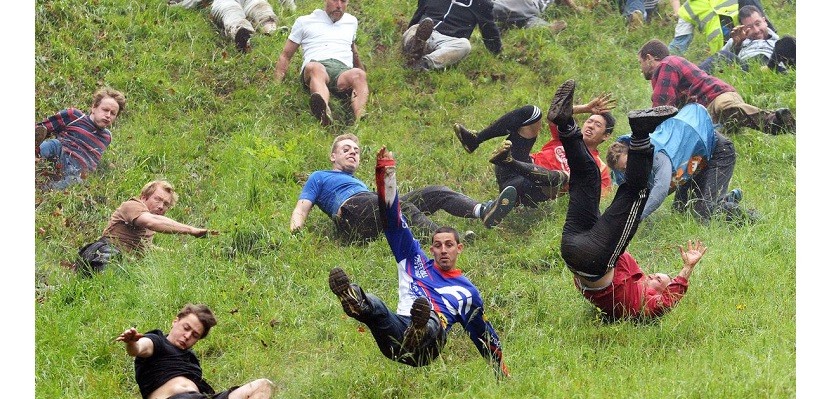Cheese Rolling in Gloucestershire

Welcome to English Waves! I’m Sarah Heath with this month’s program on traditions around the globe.
Cheese-making may principally be the domain of the French but inventing a competition involving cheese, running down a very steep hill and frequently broken bones at the end of a race, can only involve the strange compulsion to self-inflict pain of the British! This slightly unusual contest is better known as cheese rolling!
Six kilometres from the town of Gloucester in the south-west of England, is an unnoteworthy slope near the village of Brockworth, called Cooper’s Hill. Every Spring Bank holiday however, this slope with its average gradient of 45? claims the heroic title of “the world’s most dangerous footrace”.
Traditionally held for the people local to Brockworth it is now internationally known and attended by people from all over the world. Thought to have its origins in the pagan ritual of rolling objects down the hill to welcome in the arrival of the new year after winter, it was first documented in 1826 in a message to the Gloucester town crier. It has also been suggested that it was set up in relation to grazing rights on the nearby common.
It has given the Double Gloucester cheese a cooler, more funky profile than your common-or-garden Camembert. Double Gloucester is made with double cream and has a nutty, buttery taste. It is also very hard and was apparently tested once-upon-a-time by cheese buyers who allegedly jumped up and down on the cheese to check its grade: a firmness which makes it ideal to roll down a hill at great speed! The supplier of the race cheese is a local cheesemaker who has produced the race cheeses since 1988.
The rules are simple: a 3-4 kilogram round of Double Gloucester is set off rolling at the top of the 200-metre slope just one second before the swarms of competitors make chase. The more-than-somewhat masochistic contenders then hurl themselves after the cheese at breakneck speed: the cheese itself can reach speeds of up to 100km/h.
What ensues is carnage: human bodies looking like ragdolls as they bounce down the unforgiving, and usually very muddy, hill. Competitors are hurled into each other as they fall and half those taking part largely descend on their behinds! A line of ‘people catchers’ wait at the finishing line to pull competitors to their feet or to carry the injured to the very necessary first-aid tent, as the race is reknown for the number of casualties it claims. These vary from bumps and bruises to broken bones. In 1997, there were 33 separate injuries.
The winner is the first person over the finishing line. The prize is the cheese itself! Last year, a serving soldier beat the record for the number of races won – an impressive 22 in the past 14 years. And he prefers cheddar cheese to Double Gloucester! In the women’s race, half a dozen female participants have won three times.
This year’s races are being held on May the 27th. It is a very informal affair: there is no need to sign up nor to pay an entry fee. There are three races for men and one for women and while numbers are usually limited to fourteen per race, the rules are flexible!
Listen in to English Waves for next month’s program on world traditions.








COMMENTS